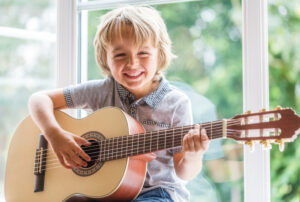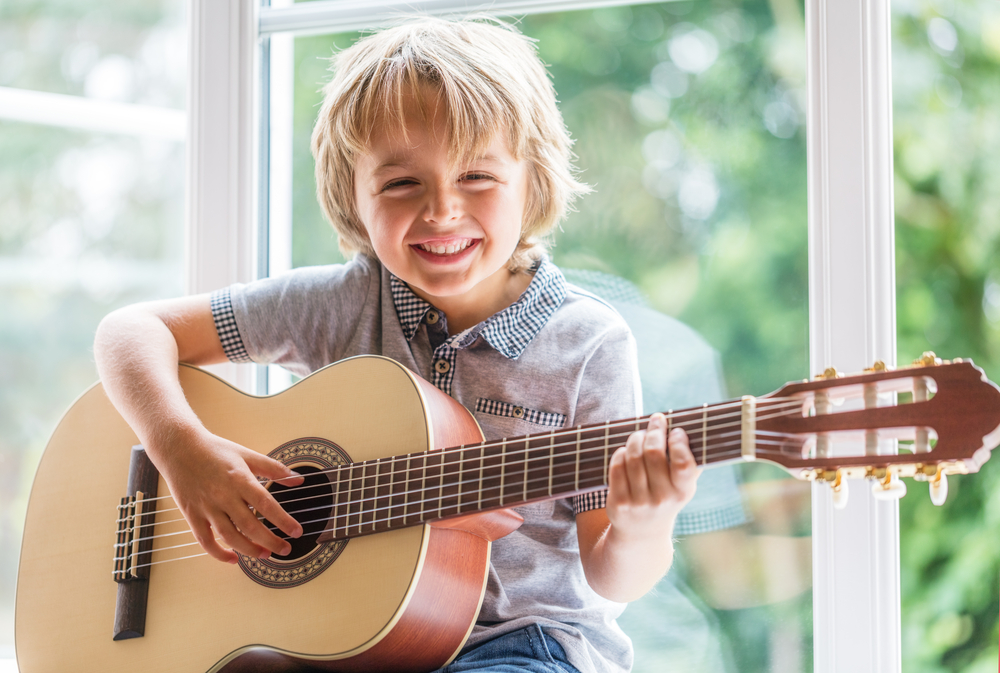
If your child is beginning his or her musical journey, you are likely scouring the web for the best information: where to find a great music teacher, where to purchase an instrument, and all the benefits of in-home music lessons for kids. At the start of this journey, one of the biggest factors to consider is the instrument your child will play. While musical instruments for kids are as varied as can be, certain ones may be better for your child than others.
Choosing an instrument should be a fun and exciting time where your child gets a chance to explore, try new things, and make their own decisions. You and your child will likely need to discuss instrument choice, but we’re confident that you’ll find a great instrument that your child will love to play for years to come. As you’re doing research on the best musical instruments for children, here are some of the top factors to consider:
- Your child’s interests and musical tastes
- Your child’s personality and passions
- Your child’s age and size
Each of these factors should play a role in the decision-making process. While it’s best to be thorough in your exploration of options, don’t let indecision stall the start of your child’s lessons. Even if he or she isn’t sure what instrument to play, an experienced and qualified music teacher can often lead you both in the right direction. Music lessons are meant to be fun, and we know that when music is presented in the right way, kids can’t help but succeed.
Consider Your Child’s Interests When Choosing An Instrument

As with any decision involving your child, you want to make the best choice, both short-term and long-term.
While we don’t recommend letting a four-year-old pick whatever instrument strikes their fancy on a given day and investing in lessons right off the bat, we do suggest letting your child take an active role in selecting their instrument. While you can’t hand them the reins entirely, considering their interests is an important part of the process.
How varied are their musical experiences? If your child has only ever listened to classical music in your home, chances are they will likely prefer a string instrument. But the more variation in music your child experiences, the more likely they will select an instrument that truly suits them. Vary their musical experiences so they gain exposure to many different instruments and musical genres, and they won’t feel so stuck in a box when making a decision. Take them to concerts, concertos, symphonies, and ballets. Watch musicals on the stage and screen, and give them every opportunity to try out different instruments.
Do they have some control over the decision? You may have your heart set on your child being the next Jimi Hendrix, but if their heart isn’t in it, music lessons may not last as long as you’d like. There is certainly something to be said for encouraging them to branch out and try something new, but they should have some say in the decision-making. Of course, how much weight their opinion holds will be based on a number of things, including their age and what’s feasible for you as a parent. But remember that if your child feels responsible for the decision-making, they are far more likely to feel invested and stick with their commitment.
Think About The Kind Of Music Your Kid Likes
While it’s not a hard and fast rule, it’s important to think about the type of music your child likes. If your child likes rock, they don’t definitively have to play the drums or guitar. But if that’s the style of music they enjoy listening to, they may not be thrilled when you suggest they learn how to play the violin.
A big part of considering your child’s musical tastes is exposing your child to enough different genres that they truly know what they enjoy listening to. Younger kids may only like upbeat pop music, whereas an older child may have enough experience with different genres that they can truly speak to what their preferences are.
Regardless of how much exposure they’ve had to different music styles, your child can succeed with nearly any instrument they select. An experienced music teacher can help your child learn to play any instrument they desire and may be able to help them select the ideal instrument for them as well.
What Is Your Child Passionate About?
Regardless of what your child likes to do in his or her free time, music is something everyone can enjoy. In some cases, however, your child’s other interests may help you decide which instrument to steer them toward.
If your child is passionate about being active and loves sports, they might be well-suited for a percussion instrument that constantly keeps them moving and keeping the beat. If they are quieter and enjoy things like art, reading, and science, they might enjoy playing the violin, flute, or piano. Children who are more extroverted and are passionate about socializing and having fun might be better suited for the trumpet, trombone, saxophone, or clarinet.
You may find that your child’s interests and passions seem to align with his or her musical preferences or even their selected instrument, but that’s not always the case, and that’s okay. The most important thing is that you make a decision that both you and your child are happy with and that you are both doing your part in supporting the experience and continuing the journey.
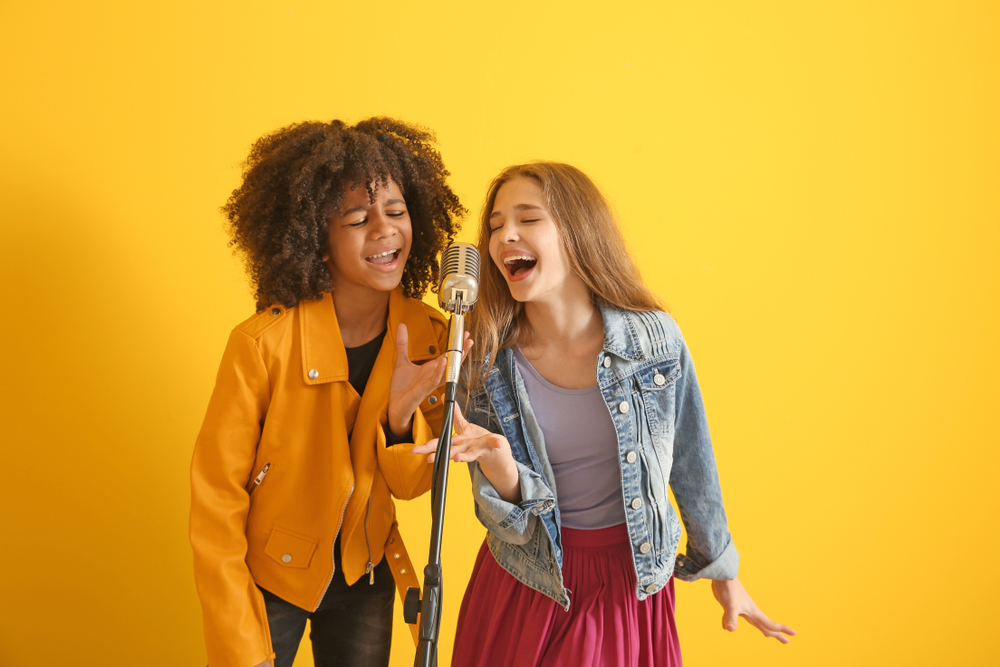
Support Your Child’s Interest In Learning Music
As the parent, you get the great job of walking alongside your child as he or she explores and discovers the wonder of music. What a fantastic journey to be a part of! You have some important responsibilities in keeping your child on track in their musical journey to ensure they get the most out of every step.
By giving your child what he or she needs to be successful in learning their instrument, you are giving them the best chance to fall in love with music. Make sure their instrument is suitable for their size and skill level, ensure they have a place to practice, and encourage them along the way.
Make sure your child is committed to their instrument and the learning experience, and support them by showing up for lessons and performances, sharing their success with family members and friends, and speaking positively about their growth and learning. The more support you offer your child, the more likely he or she is to continue playing their instrument and honing their skills for years to come.
Consider Your Child’s Personality When Picking An Instrument

Certain personalities just seem to fit certain instruments, don’t they? Have you ever met a super shy drummer or a trumpet player who doesn’t love being the center of attention? Have you met a wildly outgoing violinist or a saxophone player who was extremely serious? Yeah, we haven’t either.
While personality type and musical instrument choices are not an exact science, there is something to be said for pairing certain personalities with specific instruments. That’s not to say some people don’t break the mold. If your introvert, shy, book-loving child dreams of becoming a star drummer, they should go for it! But generally speaking, you can probably eliminate some instruments from the start just by considering your child’s personality.
Kids who love to run, jump, play, and never stop moving will generally enjoy any variety of percussion instruments.
Kids who are extroverted and love being the center of attention will thrive playing the trumpet, trombone, or saxophone.
Kids who are a bit more serious and subdued may love the piano, violin, flute, or oboe.
Consider A Child’s Age & Size When Picking An Instrument
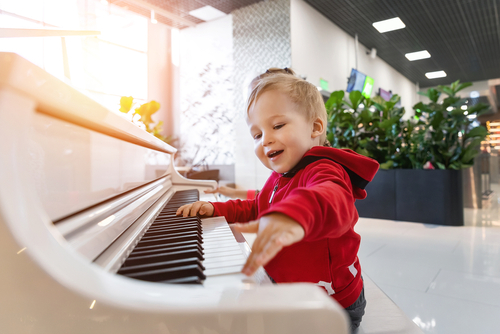
Here at Lessons in Your Home, we’re committed to making your child’s instrument choice work.
If that means finding a specially-sized instrument to fit them or starting with a similar instrument before transitioning to their dream one, we’re all in. But as you’re looking to select the instrument they want to start learning right now, it’s pretty important to consider their age and size.
A child’s age matters in selecting their instrument because of their motor skills, brain development, mouth and breath abilities, and hand size.
Height also plays a role in selecting the best instrument for kids. While this pairs with age to some extent, some older students who are on the shorter side may struggle with certain instruments than their taller peers may not. This is due to smaller instrument availability, transportation required for instruments, and the child’s physical strength.
Why Does Age Matter In Selecting Musical Instruments?
We’ve said it before and we’ll say it again: we’re committed to helping your child play the instrument they feel strongly about playing.
That being said, we do have some recommendations about some instruments being more suitable for certain ages, and for good reason.
Their age matters for a few reasons:
- Motor Skills – Younger kids lack the fine motor skills to play certain instruments, like the oboe or clarinet. They may also lack the gross motor skills they need to hold an instrument and play it simultaneously.
- Brain Development – A kid’s ability to manage all that’s asked of them while playing an instrument needs to be appropriate to his or her age and level of brain development. Just like you would never expect a two-year-old to play even a simple xylophone masterfully, certain instruments may be a bit too complex for younger musicians. Musical comprehension is an important part of learning to play instruments, and some require a more in-depth musical knowledge that beginning youngsters simply won’t have.
- Mouth and Breath – Certain instruments require specific mouth positions that younger kids may struggle with, and breath control can also be challenging for younger musicians with a smaller lung capacity.
- Hand Size – It’s harder to reach certain keys or strings if a child has smaller hands. Certain instruments, like the violin and guitar, are available in child sizes, but not all instruments are, causing problems for little hands.
Their height is an important factor to consider as well:
- Child-Sized Instrument Availability – While many instruments are available in child-friendly sizes, some are very hard to come by. Others may not be available in smaller sizes, meaning children have to struggle with larger instruments or simply wait until they are taller to play a specific one.
- Transportation – Certain instruments may not need to be transported, but most do, and shorter children may struggle to carry and take care of some larger instruments.
- Physical Strength – This goes with the two previous factors, but it also plays a role in how strong your child is in terms of holding the instrument while playing. For instance, a small elementary-aged child would likely be unable to hold up a tuba or bass, so those instruments may need to wait until they are taller and stronger.
Instruments To Learn Based On Age
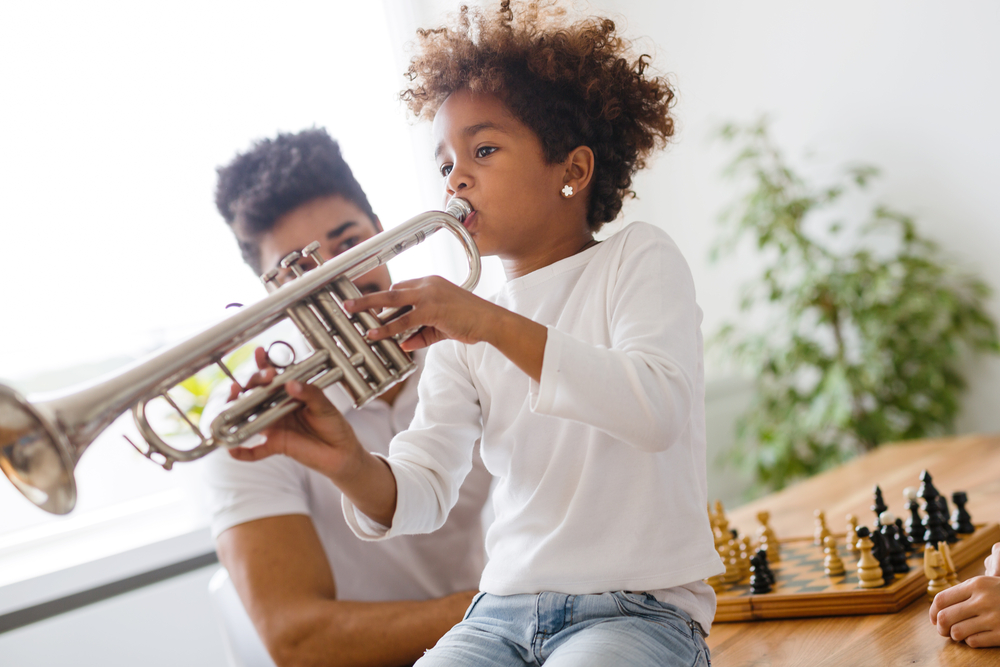
Depending on your child’s age, he or she might be better suited for specific instruments. However, some kids are capable of playing instruments that are considered advanced for their age, and we’re always willing to give music lessons in your home a try if your child is set on a specific instrument. However, we tend to stick to our general guidelines for the best instruments for specific age groups.
- Piano – 4-5 years – Piano offers a solid foundational knowledge of music that we believe every musician should acquire early on. Truly anyone can learn to play the piano, and it is a fantastic starter instrument, even for the youngest musicians out there.
- Violin – 4-5 years – Similar to piano, violin offers a tremendous foundation of musical skill and theory that will serve them well in all future musical endeavors.
- Viola – 6-7 years – With a few more advanced skills and knowledge required, the viola is still a great starting instrument for those looking to dive into the world of string instruments.
- Cello – 7-9 years – With the same foundational skill set offered by piano and violin, cello is a gorgeous string instrument that requires dexterity to master, making it a fun challenge for slightly older school-aged kids.
- Guitar – 7-9 years – Everyone loves guitar, and its versatility is fun to learn and share with others. While some kids prefer to start guitar younger than 7, we think the 7-9 age group is the perfect age to begin this favorite instrument.
- Drums – 7 and up – Percussion instruments are loved by many, and countless kids want to learn how to play them. While they can start simple, they quickly compound into complex music mastery that will keep students learning and growing for years.
- Trumpet – 8-10 years – Trumpets are a popular instrument because of their simplicity, tone, and playful allure. Mouth positions and breath control are big with the trumpet, which is why it’s on the slightly older end of our beginner instrument list.
- Trombone – 8-10 years – Precision with the slide, breath control, and mouth positioning are all keys to mastering the trombone. Additionally, arm length and physical strength are important to play this instrument well.
- Saxophone – 9+ years – Any jazz-loving kids are sure to ask about playing the saxophone. While it may not be a greater starter instrument, many kids will transition to it around age 9 or later to make the most of its gorgeous sound.
- Flute – 9+ years – More than most other brass and woodwinds, the flute requires precise mouth positions to play it well, so it’s typically suggested for older elementary-aged kids.
- Clarinet – 9+ years – Another highly sought-after instrument, the clarinet is harder to play than many expect, so it’s generally reserved for older music students.
- Bass Guitar – 9-10 years – If your child is set on playing the bass guitar, having them start on a regular guitar is a great stepping stone. It will give them foundational knowledge and skills that they can build on to eventually be playing the bass guitar at age 9 or 10.
What Are The Instrument Choices?
Several instruments make great choices for kids to learn as they begin their journey as a musician. The specific instruments available will depend on their age and size, but these are the primary categories of instrument choices:
- Woodwinds
- Strings
- Brass
- Keyboard/Piano
- Percussion
Even if you or your child has your heart set on a particular instrument or category of instrument, trying out different options is always a good idea. The more exposure to different instruments you can offer, the better. When paired with the best teacher and an instrument that suits your child, they will be sure to love music and thoroughly enjoy learning their new skill.
Woodwind Instruments: What Woodwind Instrument To Learn?

When most people think of woodwinds, they generally envision those that utilize a wooden reed to produce sounds, such as a clarinet or saxophone. These are indeed woodwinds, but so are flutes. Woodwinds are not, as their name suggests, made of wood, but rather they typically use a wooden reed to create sound.
Woodwind instruments require good breath control, proper mouth positioning, and precise finger movements. This means that most of these instruments will be better for students around 9 years and older, particularly as starter instruments. Here are some of the top woodwind instruments for kids:
- Flute
- Clarinet
- Saxophone – alto, tenor, and baritone
- Oboe
- Bassoon
Cost of Woodwinds
As with most musical instruments for kids, the cost rises as the size of the instrument increases. Flutes may be available for around $200, clarinets can usually be purchased at between $200 and $400, and an alto sax will generally run around $350. Bassoons and oboes are going to cost more because they are larger, and the students who play them are generally older and more invested in their woodwind lessons.
Upkeep of Woodwinds
All instruments require upkeep and care, but woodwinds are a little heavier on their maintenance needs. Because wood is involved in their makeup, it’s hugely important to keep them dry when storing. Musicians should never leave anything inside them that will hold in moisture, but they should clean and dry the inside and outside of the instrument after each use and before storing.
Instruments should always be stored properly and safely so they cannot get damaged. They should be disassembled after each use, and cork grease should be utilized on any cork tenons or neck corks to help when assembling. Woodwinds should be professionally cleaned and examined twice a year to ensure it is in proper working condition and has not sustained any damage.
String Instruments: What String Instrument To Learn?
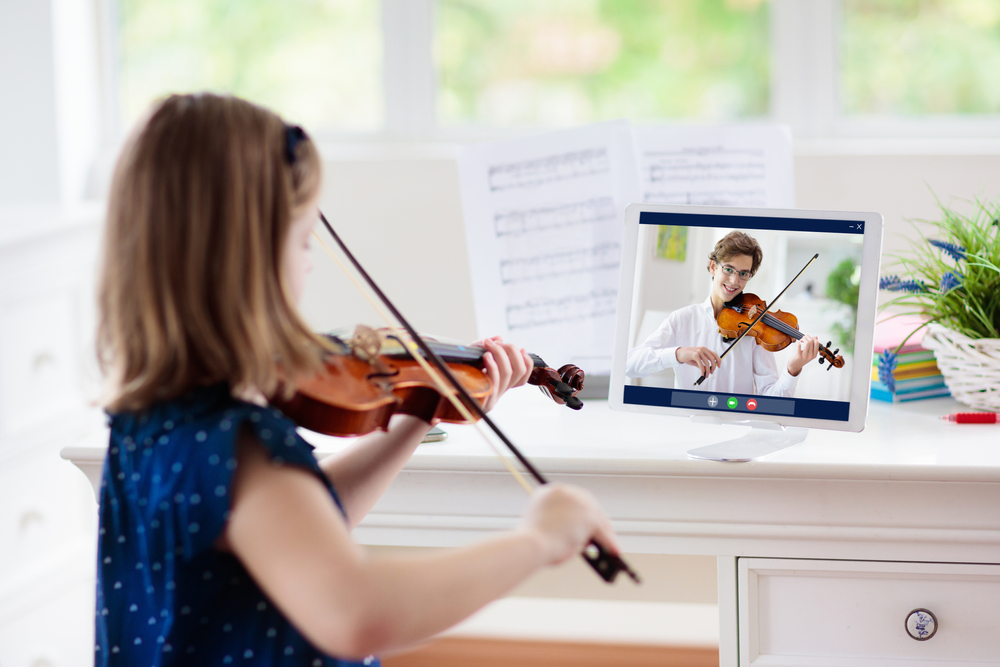
String instruments generally fall into two categories: bowed string instruments and guitars. Bowed string instruments in an orchestra include:
- Violin
- Viola
- Cello
- Bass
Many young students love to learn guitar, but this category of string instruments is far more versatile than some may realize. They can include:
- Acoustic guitar
- Electric guitar
- Bass guitar
- Ukulele
Violin is, by far, the most popular starter instrument in this category. It gives students of all ages great foundational knowledge of musical concepts and allows musicians to expand their skills and build on them as they continue with lessons.
Cost of String Instruments
Perhaps more than any other category of instruments, string instruments can vary in cost a great deal. You may be able to find a secondhand child-size violin for $50, but you may have also heard of professional violinists spending as much as $10,000 on one instrument. While you likely won’t have to worry about hitting that higher price point, the range of prices can feel overwhelming.
If you’re looking to purchase a bowed string instrument for string lessons, you’re likely looking at around $100 to $800 for a violin or viola, and around $1000 for a cello or bass. Guitars can start at around $100.
Remember that renting instruments is a great option, especially when your child is just beginning and they tend to be a little rough on their instruments. If you need a child-size instrument, renting is a great option because your child will likely outgrow it quickly.
Upkeep of String Instruments
Bowed string instruments will require standard maintenance and upkeep after playing them and throughout the year. For optimal performance, here’s what your child will need to do after each practice session or music lesson:
- Wipe down bow – String instrument players will put rosin on their bows to increase stickiness on the strings to create an ideal sound. But when rosin remains on the bow, it can dry it out and cause breakage or a need to restring the bow early.
- Wipe down strings – The rosin from the bow can also remain on the strings, so they should be wiped down to reduce problems.
- Wipe down the entire instrument – Wood needs to be cared for, and the more you take care of the instrument, the better it will look and the longer it will last.
In addition, you may need specialized cleaning oil for the strings or wooden body, and the instrument will need to be stored properly when not in use. In terms of regular maintenance from a professional, you may need regular cleanings, string replacement, and restringing of the bow occasionally.
Brass instruments: What Brass Instrument To Learn?
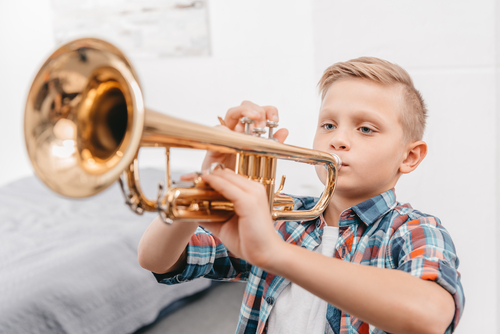

Brass instruments are widely popular in bands and orchestras everywhere, with people of varying ages playing each of the different brass instruments. The majority of instruments that fall into this category are easy to find, and they are pretty reasonably priced. They create a great sound that can be more enjoyable to learn, as they won’t often create troubling sounds for beginners like string or percussion instruments might.
Here are the most popular brass instruments:
- Trumpet
- Trombone
- Tuba
- French Horn
Several variations of each primary instrument exist, including more unique brass instruments like the cornet, flugelhorn, euphonium, alto horn, sousaphone, and tenor horn. Trumpet and trombone are the most commonly played brass instruments for kids, as they are more foundational instruments that will give children a basic knowledge of how brass instruments work and how to master brass techniques.
As with any instrument, you should have your child try a few different brass instruments if they are interested in them and see how they feel, especially before they start brass lessons. Most brass instruments are best suited for slightly older elementary kids (or older), as they require certain levels of dexterity, size, and breath control to play well. Additionally, finger size, lip width, and having braces can all play a role in how well a child can handle some of these brass instruments, so it’s a great idea to consult with an experienced music teacher before committing to a specific instrument.
Cost of Brass Instruments
As stated, brass instruments tend to be affordable and easy to find for purchase or rent. While you may be able to find some great deals online from used instrument sites or places like eBay, we generally recommend visiting a physical music store in your area to ensure you’re getting a quality instrument. While spending less at the start may seem better, you will likely spend more on maintenance and repairs than if you just begin with a higher-quality brass instrument. Here are some of the starting costs for brass instruments for kids:
- Beginner trumpets range from $200 to $400
- Student trombones range from $400 to $600
- Quality tubas, even for students, cost around $3,000
- French horns typically cost around $1,400
Generally speaking, brass instruments are easier to maintain than most other instrument families. As with any instrument, they should be kept in their cases when not being played so as to avoid structural damage. You should drain the water from the instrument after each use and wipe the mouthpiece out after playing. Once a week, you should wash your mouthpiece, and you can put oil on the lead pipe of the mouthpiece to keep it from getting stuck. Once a month, you should thoroughly clean your instrument, and you should get it professionally examined and maintained at least once a year.
Keyboard Instruments: What Keyboard Instrument To Play?
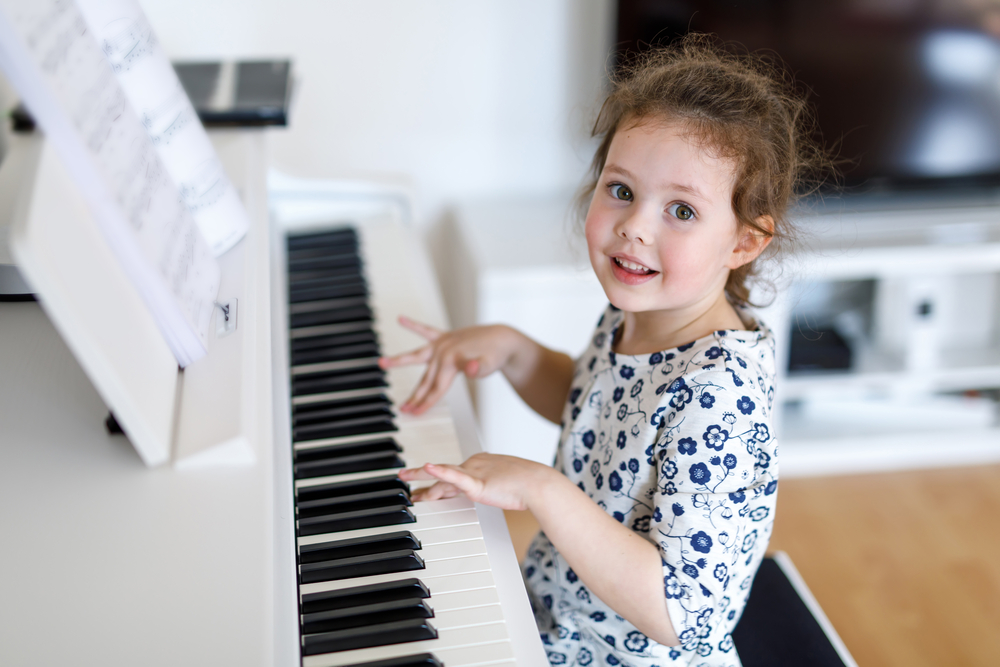
The category of keyboard instruments really only contains one instrument: the piano. While some people will learn or practice on a keyboard or digital piano, the actual result is being able to play the piano.
The piano is a fantastic instrument that is a great choice for literally anyone and everyone. Young kids and adults alike will enjoy taking piano lessons and learning to play the piano for a number of reasons. It offers a fantastic theoretical base of information and musical knowledge, which can translate to nearly any other instrument or musical skill in the future. The piano’s versatility is neverending, as it can be played solo, in small groups, or in an orchestra. Pianists can also learn to play almost any variety or genre of music they desire.
Pianos are not something that can be transported easily, but most piano teachers will highly recommend having an actual piano to practice on while learning the instrument. If you do opt for a keyboard or digital piano at home, it’s best to get a full-size keyboard that has all 88 keys that a piano has. You should also get one that has weighted action keyboards. These keys will emulate piano keys more precisely, so the instrument’s tone will be based on how hard the pianist presses the keys. If you select a keyboard but don’t consider these two factors, your child may learn bad or strange habits that they will eventually need to unlearn to improve their piano playing.
Cost of Keyboards and Pianos
It’s no surprise that pianos can be quite costly. They are large and complex, requiring specific transportation and moving services to get them into your home safely.
- Upright pianos can range from $3000 to $6500 on the lower end.
- High-end upright pianos average between $10,000 and $25,000.
- Entry-level grand pianos cost between $7,000 and $30,000.
- High-end grand pianos range from $65,000 to $190,000.
It’s safe to say you’re probably looking at the lower end of that list. If even that is a stretch, you may be able to find one second-hand at a lower price, and you can simply hire someone to tune it and ensure it’s in good working condition.
If a piano is out of reach or you don’t have space, a high-quality keyboard or digital piano will suffice. Remember, you want a full-size keyboard with weighted action keys. These typically start around $300 for a basic version and can stretch up to $2500 or higher for a more advanced version.
Upkeep of Keyboards and Pianos
The basics of piano upkeep will apply to both traditional pianos and digital ones:
- Keep them clean and free from dust (buy a dust cover!)
- Keep food and drink away from them
- Avoid putting them under a shelf where something can fall on them
- Avoid putting them near doors and windows to keep them safe from slamming doors, sunlight, and weather
- Wash your hands before use
Additionally, pianos will need to be tuned regularly. During the first year, they will probably need to be tuned twice. Moving forward, one tuning per year should suffice.
Percussion Instruments: What Percussion Instruments To Play?
Countless kids dream of becoming drummers, but most of them don’t understand that they likely won’t be able to just pick up some drumsticks and get to it. Drums fall into the category of percussion instruments, which actually includes a large number of instruments that help round out the sound of bands and orchestras everywhere. Here are the top percussion instruments:
- Xylophone
- Tambourine
- Marimba
- Bell
- Cymbals
- Timpani
- Triangle
- Maracas
- Gong
- Woodblock
- Snare drum
- Bass drum
- Tenor drum
Depending on how and where your child wants to play percussion, they may learn one or several of these instruments. For example, students who learn to play percussion in a middle school band will generally learn several percussion instruments to begin with before selecting one or two primary ones to play in high school. A child taking drum lessons independently will have more opportunity to select one or a few specific percussion instruments to specialize in. Most percussionists are experienced at many different instruments, however, which allows them versatility if a song doesn’t require their primary instrument.
Cost of Percussion Instruments
The cost of percussion instruments varies a great deal because the instruments themselves are so varied. You may be able to get a decent xylophone for under $100, but a marimba may run you up to $2,000. A full drum kit may be purchased for around $300, but higher quality kits can cost more than $1,000. Many music stores will sell percussion kits, which include a few different percussion instruments all in one set. This may include a snare drum, bell set, and a drum pad, along with sticks and mallets. These kits can run between $300 and $400, but they are a good starting point if your child is interested in playing a percussion instrument but isn’t sure which one.
Upkeep of Percussion Instruments
Taking care of your percussion instruments will ensure that they sound good and look good for longer. Keep them stored in cool, dry places when they aren’t in use, and each piece should undergo a thorough cleaning at least once per year. This involves taking the heads off each drum, cleaning and lubricating each part individually, and then reassembling the drum. This may be best suited for a professional, but it’s something to factor into your regular maintenance and upkeep.
Additionally, most percussion instruments will need to be tuned regularly, and they will need to be wiped down frequently to ensure they stay free from dirt and grime.
Other Important Things To Consider When Choosing An Instrument
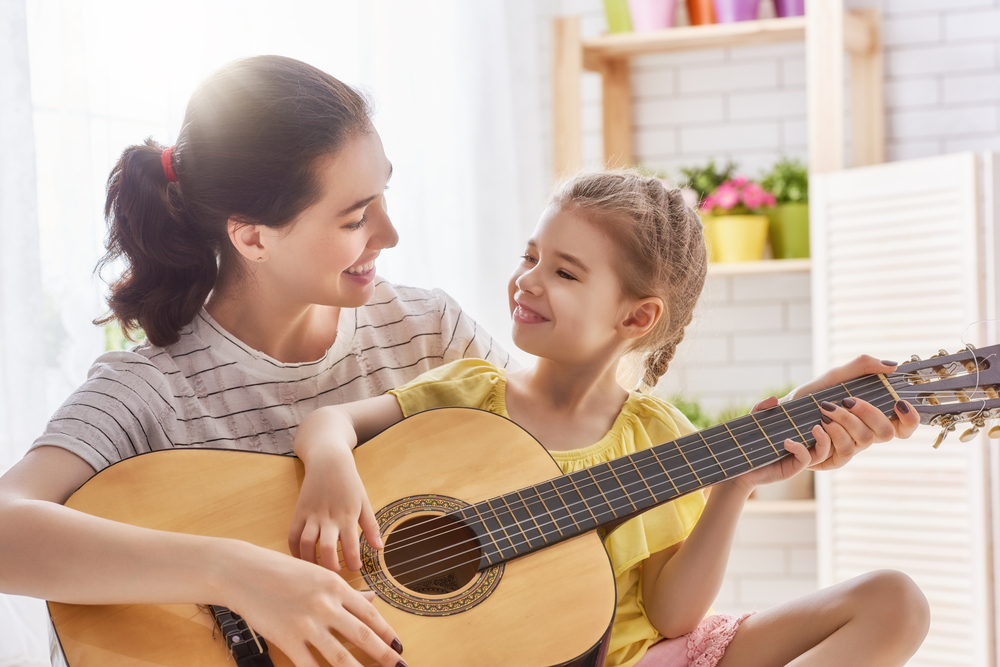
As you go through each instrument category and consider all the different factors that go into selecting an instrument for your child, there may be a few questions that remain. If you haven’t already thought through every detail, here are a few more important things to consider when choosing your child’s instrument.
Short-Term and Long-Term Cost
The upfront cost of an instrument is one thing, but what about the long-term cost? If you purchase an instrument now that is on the less expensive end, will you need to replace it in a few years? Or if you are purchasing a child-size instrument, how quickly will your child outgrow it? How costly are instrument repairs and how frequently do they occur? These are great questions for a professional music teacher or a staff member at a local music shop.
Space in Your Home
This is simple but often overlooked. Do you have the physical space in your home for your child to practice his or her chosen instrument? While not all instruments take up as much space as a piano, your child will still need a dedicated space to practice. This area will require a chair or stool, a music stand, and space for the instrument case. It should be a quiet area that is somewhat private, so the child won’t be interrupted during practice and so the instrument is not in danger of being damaged.
Exploring Instrument Options
Has your child had a chance to play around with multiple instruments? Have they been exposed to enough different options and categories of instruments to make a definitive decision about which instrument they prefer? While schools are usually great about letting students explore different instruments, younger kids who play outside of school don’t always have this luxury. Many music shops will offer kids this opportunity or a local school may open the doors to youngsters to try out some instruments, so be sure to look into this before officially selecting an instrument for your child.
Music Teacher
Who will your child’s music teacher be? Some professionals think this is just as important–if not more so–than the instrument itself. You want your child’s music teacher to be excited about the instrument and excited about teaching. This will help get your child excited as well, and it is likely to keep them more motivated to learn and thrive if their music teacher is passionate. You also want the learning process to be ideal for your child, and you want them to connect with their teacher so that they form a relationship and bond.
Next Step: Finding The Right Music Teacher
Finding the right teacher is key to your child’s success and enjoyment as a musician. You must make sure the teacher connects well with your child to encourage and support him or her in this new journey. You want someone who loves music, makes it fun, and constructively corrects and instructs your child in their new craft. Lessons in Your Home has teachers for every instrument you can imagine in a variety of cities all across the nation, and they can provide lessons both online and in the comfort of your very own home. Our teachers’ credentials and experience speak for themselves, and we’re confident that you’ll find a fantastic music teacher to help your child on their new musical journey.
